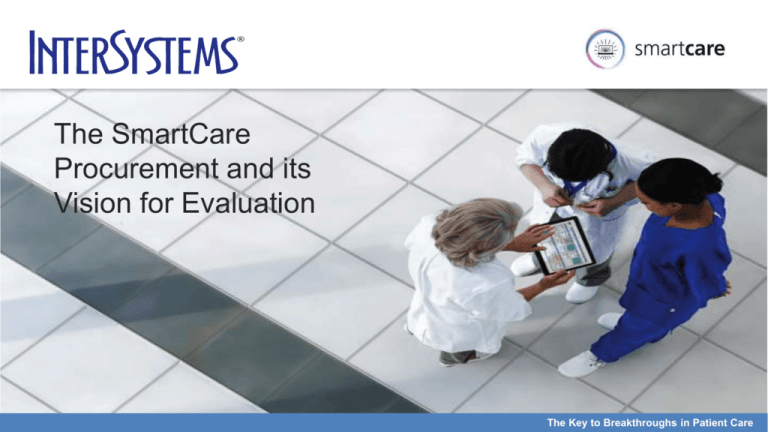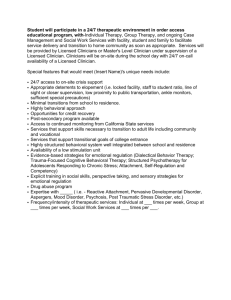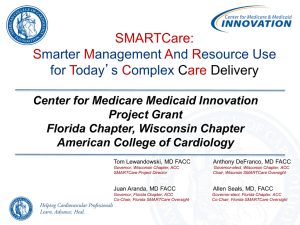SmartCare - InterSystems
advertisement

The SmartCare Procurement and its Vision for Evaluation The Key to Breakthroughs in Patient Care SmartCare Gareth Evans – SmartCare Programme Manager - GHT What is SmartCare? SmartCare is the collaborative procurement and implementation of a Managed Service for an Integrated Clinical Information System Gloucestershire Hospitals NHSFT Northern Devon Healthcare NHST Yeovil District Hospital NHSFT Background All three Trusts are operating on legacy systems of 20+ years (HP Swift/Swift+). All lack functionality to capture true clinical information. Limits the Trusts ability to progress with Clinical Pathways in an integrated manner and satisfy NHS vision. All have a history of aborted attempts to provide a full clinical solution. Vision • Provision of current and sustainable systems and technical infrastructure to support the Trusts to provide high quality patient care. • The collaborative will enjoy strategic benefits of better quality, improved patient safety and efficiency. • One patient, One record’ accessible wherever it is needed. The Requirement • • • • • • • • • • Clinical Administration Pathology Pharmacy & Pharmacy Stock Control Emergency Department Theatres Women’s & Children’s (Maternity + Neonatal + Paediatric + Gynaecology) Oncology e-prescribing & Oncology management Order Communications Electronic Prescribing and Medicines Administration Clinical Documentation, Decision Support and Reporting Collaboration – Why? ££££’s – 4-Years of Central Funding offered for a collaborative procurement. Shared Vision Shared Risk Same starting point Collaborative Procurement – How? Joint Executive Sponsorship – CEO level Joint Governance Joint Requirements Development Joint Clinical Leadership Excellent Working Relationships Excellent levels of understanding – Clinical & Business Joint desire to succeed! Procurement - The Restricted Procedure Traditional route of Competitive Dialogue no longer approved for Central Government backed procurement. Specific & detailed requirements agreed by all – even clinicians! OGC IT Services Contract to be applied – puts the restrictive into Restricted! Single Lot procurement with three Trust contracts Clear procurement process, well managed. Legal Involvement Probably the Most Important investment! DAC Beachcroft (other legal advisers are available) • Excellent advice • True collaborative working saves cost • Experienced (on both sides of the fence) • Investment saves time and money! Evaluation – How we did it….. Innovative Approach Strong Clinical Engagement Usability is key Over 200 evaluators • ITT response – 6-weeks • Virtual Hospital – 5x Clinical Teams for a week • Demonstrations – Multiple teams per day • Finance – Lower weighting than usual! Evaluation – What was different? Virtual Hospital Designed to enable evaluators to assess usability of a clinical system by means of training and use. Enabled subjective evaluation to be carried out in a structured manner Full clinical involvement Excellent vendor platform for demonstrating real usability Virtual Hospital A common problem with systems selected by OBS response and demonstration is that staff will not have a clear view on how usable the solution is. This will effectively alienate key staff groups, especially clinicians and result in a poorly used and potentially unsafe solution. Dr Michael Richards’ vision for resolving this issue was to create the Virtual Hospital as a key part of the systems evaluation. Virtual Hospital takes advantage of many system suppliers claim to provide initial training in just a few hours for clinical and non-clinical staff. Virtual Hospital The objective of the Virtual Hospital process is to evaluate the usability of the system in simulated real life. In order to achieve this, a minimal hospital structure with clinical areas is required to be pre-programmed into a training system. Virtual Hospital - Structure • • • • • ED: reception area, 12 bays and 2 resuscitation areas. Medical Ward: reception area, 20 beds in 5 bays Surgical Ward: reception area, 20 beds in 5 bays Maternity suite: 10 beds and 10 delivery rooms Theatres: Two main theatres and an emergency theatre – with the ability to manage a real time waiting list for the emergency theatre list and schedule cases to the elective theatres. • Simple future outpatient appointments diary for each doctor in the Virtual Hospital. Virtual Hospital - Evaluation The evaluation consisted of 5-teams of 10 people being trained in each system and undertaking the Virtual Hospital scenarios: • • • • • Ward Clerk: 1 acting for all areas 3 Nurses: 1 for each area ED, Medicine, Surgery 1 Midwife 4 Doctors: 1 each for ED, Medicine, Surgery and Maternity (1 Obstetrician) 1 Pharmacist: 1 to cover prescribing activity in all areas Virtual Hospital – System Requirements The evaluation system is pre-populated with patient demographics and clinical information provided by the Trusts. Basic functionality includes a basic clinical record per patient (Demographics, Diagnosis, Allergy recording, Scheduling of Intervention/theatres). Alert management; basic order comms; the ability to enter clinical vital signs and results manually in response to orders; and to record prescriptions and drug administration (including fluids). Prescribing clinical decision support (allergies, drug-drug interaction) should be included. Virtual Hospital – System Requirements Certain clinical assessments must be available with appropriate alert generation to clinicians when the clinical data entered creates an identified patient at risk. E.g. VTE, DVT, Pain Score Assessment, GCS, EWS with alerts. Clinical Decision Support for prescribing must include Drug – Allergy interaction alerts; Drug – Drug interaction alerts; and, as possible, Drug – Results alerts/CDS and Drug/Disease alerts. Virtual Hospital - Results for Orders It is required that results for any orders placed need to be captured by the system in the patient’s record. This will be entered by a member of the supplier’s team acting as an ‘Agent Provocateur’ (AP). At any time after an order is placed the AP will select a pre-define flash card from a pack representing the order placed (ie U&E flash card from the U&E pack if a U&E test is ordered). The ‘results’ on the flash card will be entered into the system in the patient’s record. Virtual Hospital – Clinical Data Most of the clinical data to be entered by clinicians is pre-generated and is available on flash cards to ensure all systems are exposed to the same core set of data values. There are two sets of flash cards: • Clinician • Results Virtual Hospital - Clinician Flash-Card Will provide data values for data captured directly by the role players: HT & WT, VTE assessment, Vital signs, pain scores and these will be available to all clinical role players. When instructed by the scenario script or when the role player thinks clinically indicated, the clinician should enter data into the patient record for the variable set required (eg vital signs, HT & WT etc). Any clinician can choose to enter clinical data anytime but should do so using data from the clinical flash card. Virtual Hospital – Results Flash-Card Test investigation results are entered by the supplier’s Agent Provocateur (AP). These cards are not available to the clinical role players. The AP will select the flash card for the results of the test ordered by the clinician and enter these into the system for the appropriate patient sometime after the order is placed. The role player will not be able to predict when this will occur and will have to consult the system regularly to pick up new and abnormal results or alerts. This process simulates real life and the presentation of the data by the system will be assessed for usability. Virtual Hospital - Summary • Clinical Training – half-day • Simulated real-time use against pre-populated system and clinical scenarios. • Simulated result abnormalities/alerts • Clinical Decision Support • Clinicians making decisions and entering data • Assessment of system usability • Judged by Clinicians! Virtual Hospital – Did it work? Yes! Virtually all clinicians agreed this was a useful evaluation tool. The process identified issues related to usability in all systems evaluated. However, it is a subjective method and care must be taken to ensure suppliers have the opportunity to ‘drive’ the solution in an expert manner. What was the result? InterSystems TrakCare The Future Safe, Efficient and Patient Centric EHR Three Trusts aiming for HIMMS Level 6 at full Go-Live in two-years Vision and commitment to move to HIMMS Level 7





